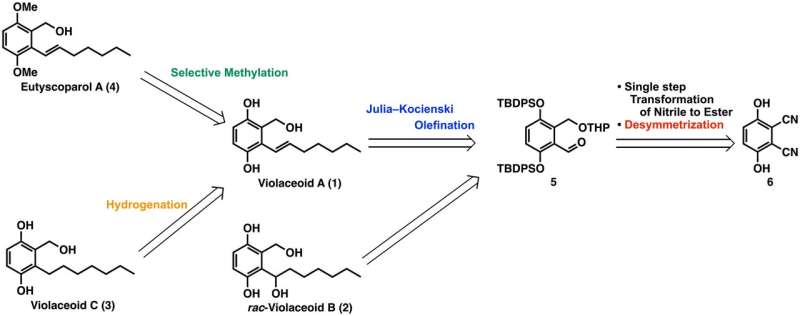This article has been reviewed according to Science X's editorial process and policies. Editors have highlighted the following attributes while ensuring the content's credibility:
fact-checked
trusted source
proofread
From fungi to pharmaceuticals: A milestone for the production of eutyscoparol A and violaceoid C

The natural world is rich in chemical compounds with remarkable medicinal properties. A notable example is penicillin, discovered by chance from the Penicillium mold. This discovery revolutionized the treatment of bacterial infections and highlighted the potential of natural compounds in medicine. Since then, the identification, isolation, and synthesis of novel bioactive compounds from plants, fungi, and bacteria have become fundamental to drug development.
Recently, two groups of naturally occurring bioactive compounds have garnered significant attention: violaceoids A–F from the fungus Aspergillus violaceofuscus and eutyscoparols A-G from the fungus Eutypella scoparia. These compounds share similar structures, featuring a 2,3-alkylated quinol moiety and a hydroxymethyl group, and are believed to possess antimalarial and antibacterial properties. Following their initial discovery in 2014 and 2020, scientists have been working to produce these compounds in larger quantities for further study.
In a recent study, researchers from Tokyo University of Science (TUS), led by Associate Professor Takatsugu Murata and Professor Isamu Shiina from the Department of Applied Chemistry, Faculty of Science, have made significant progress by developing an efficient method to synthesize eutyscoparol A and violaceoid C. Their work, featured on the cover of the Asian Journal of Organic Chemistry, and published on 25 April 2024, could lead to new treatments or drugs.
"Eutyscoparol is a group of compounds whose pharmacological activity had not been thoroughly explored. Our goal was to make this possible through artificial synthesis and support the development of new drugs," says Dr. Murata.
The researchers used a retrosynthetic analysis to simplify the production process. This approach breaks down complex molecules into simpler, more accessible materials. They used this method to synthesize eutyscoparol A (4) and violaceoid C (3) starting from commercially available dinitriles (6) through violaceoid A (1) intermediates. Dinitriles were chosen because they are easy to obtain and can be converted into aldehydes (5), which are precursors to violaceoid A intermediates. To make the aldehyde (5), dinitrile (6) was first converted into diester.
Then, the hydroxy groups in diester were protected with a tert-butyldiphenylsilyl (TBDPS) group to form protected ether. This ether was reduced to form a symmetric diol. One hydroxy group in diol was then selectively protected to create desymmetrized tetrahydropyranyl (THP)-ether, which was oxidized to produce the aldehyde.
With the aldehyde prepared, the researchers proceeded to synthesize violaceoid A (1) and rac-violaceoid B (2) intermediates through a series of reactions. To prepare violaceoid A (1), the aldehyde was first alkylated to form an intermediate, which was then converted to olefin using mesylation or the Julia–Kocienski reagent.
The THP-protecting group in olefin was removed with isopropyl alcohol to produce alcohol. Finally, two TBDPS groups were removed from the alcohol to get violaceoid A (1). Rac-violaceoid B (2) was synthesized using similar methods.
These improvements made the process much more efficient. The researchers synthesized violaceoid A (1) in 8 steps with a 33% yield, compared to the previous 10-step process that had only an 11% yield. Similarly, they prepared rac-violaceoid B (rac-2) in 8 steps with a 35% yield, improving on the earlier 9-step process with a 15% yield.
After successfully synthesizing the intermediates, the researchers moved on to produce violaceoid C (3) and eutyscoparol A (4). The synthesis of violaceoid C (3) was relatively straightforward, involving the hydrogenation of the double bond in violaceoid A (1) to yield violaceoid C (3) with high efficiency.
For eutyscoparol A (4), the researchers selectively methylated two of the three hydroxy groups in violaceoid A (1) by refluxing the reaction mixture with potassium carbonate and iodomethane. Overall, violaceoid C (3) was synthesized in nine steps with a 30% yield, and eutyscoparol A (4) in nine steps with a 28% yield.
With improved yields and simpler synthesis steps, the proposed approach makes it easier to produce these compounds on a larger scale and could lead to further research into their potential therapeutic properties.
"The synthesis of violaceoid A and eutyscoparol C on a subgram scale will help us study their pharmacological effects, which we expect to include cytotoxic, antibacterial, and antimalarial activities," concludes Prof. Shiina.
More information: Takatsugu Murata et al, Total Synthesis of Eutyscoparol A and Violaceoid C, Asian Journal of Organic Chemistry (2024). DOI: 10.1002/ajoc.202400148
Provided by Tokyo University of Science





















